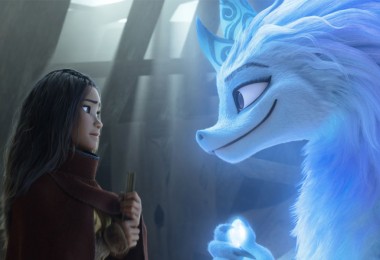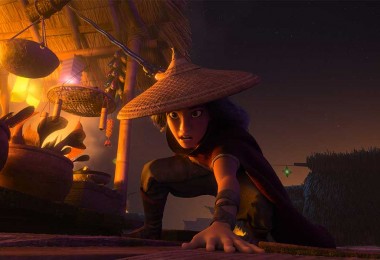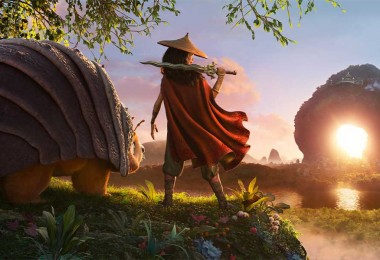By Beth Deitchman
The spirit of Women’s History Month shines through in Walt Disney Animation Studios’ newest film, Raya and the Last Dragon. The movie tells the story of a young warrior who embarks on an epic journey in the fantasy world of Kumandra as she sets out to track down the legendary last dragon, Sisu, to further her quest to restore the fractured land and bring together its divided people. Raya is a skilled warrior and Sisu possesses a delightfully unexpected assortment of magical dragon talents, but between them, the heroes also share a wealth of superpowers that includes bravery, resilience, optimism, and hope. These strong women have been brought to the big screen and Disney+ by a talented team of writers, artists, and technologists at Disney Animation who have made new women’s history during the creation of the film.
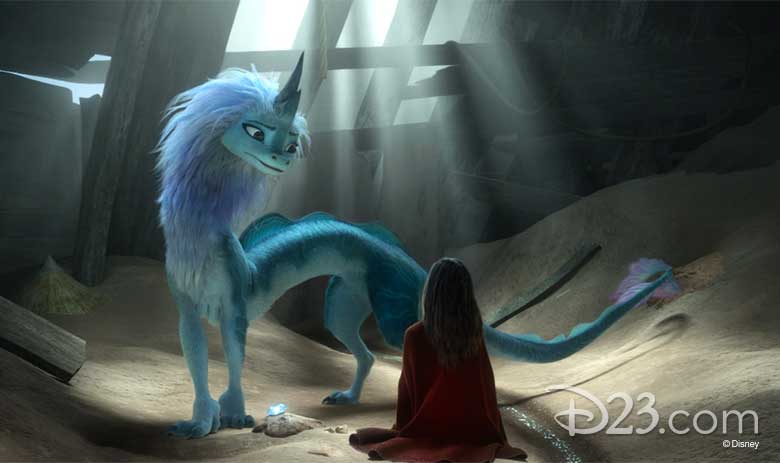
Produced by Osnat Shurer, Raya and the Last Dragon was developed under the leadership of Disney Animation’s Chief Creative Officer, Jennifer Lee; with co-writer Adele Lim, head of story Fawn Veerasunthorn, and head of animation Amy Smeed among the women leading the creative charge on the film. Additionally, Raya and the Last Dragon has an all-female technical leadership team led by technical supervisor Kelsey Hurley, and associate technical supervisors Gabriela Hernandez and Shweta Viswanathan; as well as simulation supervisor Avneet Kaur and the first woman to serve as head of modeling on a film from Disney Animation, Alena Wooten.
The amazing women working “behind the camera” on Raya and the Last Dragon couldn’t help but be affected by the powerful women characters they were bringing to life on screen. “I think we inspired each other! I come from a family of strong women, as I know do many of the other women behind the scenes, and their inspiration is apparent in the powerful characters on the screen,” Shurer tells D23. “At the same time, Raya’s courage, not just as a masterful martial artist but even more so the courage she has to be vulnerable, to take the first step towards trust, towards bringing us all together—even in the face of betrayal, setbacks, and loss—is truly inspiring to me.”
In honor of Women’s History Month, we asked some of these groundbreaking women to share what inspired them to pursue their careers and offer advice to other young women who may also want to work in animation.
Osnat Shurer, Producer

Are there mentors you credit with influencing you as you’ve built a successful career in animation, and what specific advice would you offer to women at the Studio who are in the early stages of their own careers in animation?
I have learnt so much from so many people in my career, from directors such as Brad Bird, Andrew Stanton, John Musker & Ron Clements, and, most recently, Don Hall, as well as from great visionaries I was fortunate enough to work with, such as Ed Catmull and Steve Jobs.
When it comes to women who influenced me, the greatest of these was my mother, Sarah, who would be turning 100 this week—a freedom fighter for the independence of her country, an inspirational teacher to many generations for over 70 years, and a true believer in equality and the power of common sense!
To women at early stages of their careers I would say keep going. If you encounter setbacks along the way, take a moment to feel what you feel, and then get back into it. Your story, our stories, are valuable and important and need to be told, and your voice in shaping these stories is essential.
Is there something that you know now working as a woman in animation that you wish you’d understood at the beginning of your career?
Animation is an incredibly collaborative process. As I’ve had the opportunity to work on different projects, I’ve come to see that everyone working on the film has the same goal in mind—to tell a wonderful story for the ages, filled with heart and humor, about something that is important to us. So if you see something that could be better, or more sensitively or equitably handled on screen, find a thoughtful way to bring it up to the filmmakers. While there might be a slightly uncomfortable moment, it will pass, and the film—and the filmmakers—will be better for it, having gained deeper empathy and respect.
Amy Smeed, Head of Animation
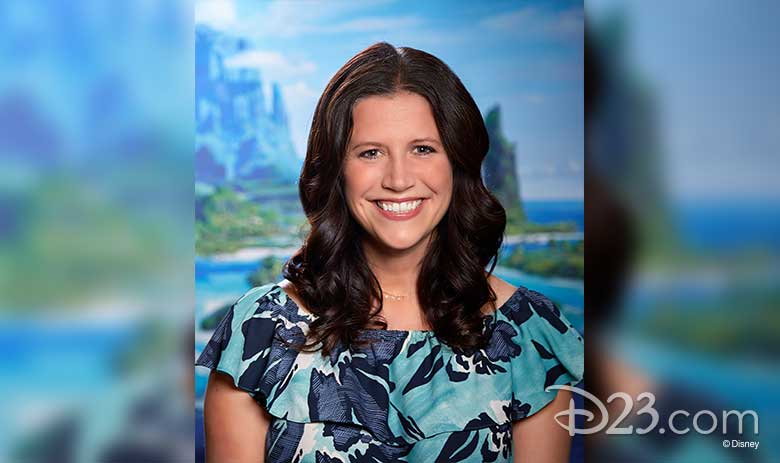
Can you describe your role in bringing Raya and the Last Dragon to the screen?
In my role as Head of Animation, we work closely with the directors to make sure their vision for the acting and performance of our characters is seen onscreen.
What made you want to pursue your career? Are there any specific films or experiences that inspired you to want to work at Disney Animation?
My favorite subjects in school were always my art classes—I especially loved my painting classes. I loved “creating” in general, and that would come out in various forms. I grew up loving animated films and seeing all the Disney films, but it hadn’t occurred to me that people were actually creating all of the beautiful artwork and characters. I spent the first few years in college studying painting before ever taking an animation course. As soon as I took that first class, I instantly fell in love with creating characters and bringing them to life. Disney has always been incredible at creating stories and characters that audiences can connect with, so it has been an honor to be part of that storytelling today.
What words of encouragement would you offer to young women who would also like to pursue a similar career in animation?
Animation is a lifelong journey. I’m still learning something new with each scene I get. It takes years to master the principles of animation, and that’s just the start. Be patient and know that you’ll make lots of mistakes, but that’s OK—we all do every single day! Be determined, believe in yourself, and stay open to critiques. Our best animators are those who are constantly seeking out feedback and those who are always pushing themselves to learn new things. It’s an incredibly collaborative medium, and something I love about creating our characters and films.
Kelsey Hurley, Technical Supervisor
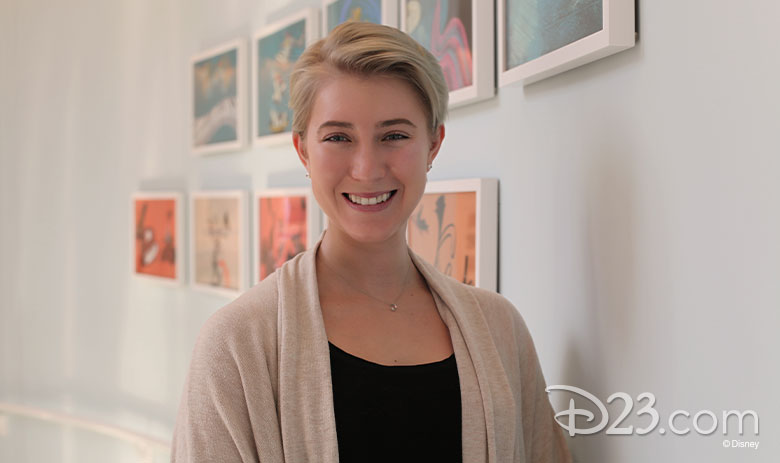
Can you describe your role in bringing Raya and the Last Dragon to the screen?
As Technical Supervisor, it’s my job to ensure we have everything we need from a technical standpoint to create the film. This ranges from making sure we have the toolsets needed, to making sure we have enough render capacity and disk space. Along with two Associate Technical Supervisors, Gabby and Shweta, we lead a team of technical directors (TDs) who provide troubleshooting support for artists as well as develop new tools for them. In conjunction with this, I lead collaboration with our engineering teams for larger development initiatives.
What made you want to pursue a career in animation technology? Any specific films or experiences that inspired you when you were younger?
As a child, I was always interested in art and computers, but growing up, I didn’t know a job like this even existed. Finally in college, I learned that there were jobs in this industry and in that moment everything I did was towards the goal of working in animation. While I love art, I’m not a strong artist, so when I found out that this job acts as a bridge between art and technology, I felt like it was the perfect fit.
What words of encouragement would you offer to women who are thinking of pursuing a similar path?
Be confident in yourself and find your voice. Those are the two things that have changed my life and let me go out for different opportunities, even when they scared me.
Gabriela Hernandez, Associate Technical Supervisor

Can you describe your role in bringing Raya and the Last Dragon to the screen?
I’m in the technical director department. In collaboration with artists and software engineers, technical directors develop pipeline tools and workflows that empower the artists to create the characters and environments in a movie. We also provide support and troubleshoot any technical issues the artists run into in their day-to-day. My role specifically on Raya and The Last Dragon was Associate Technical Supervisor for Characters. I managed the pipeline for anything character related such as Character Modeling, Look Development, Rigging, Simulation, Animation, Technical Animation, and Crowds. I had a great team by my side!
What made you want to pursue a career in animation technology? Any specific films or experiences that inspired you when you were younger?
I just love problem solving and creative environments. Being a TD at Disney is perfect for that. Every day there’s a new problem to solve.
What words of encouragement would you offer to women who are thinking of pursuing a similar path?
Don’t be afraid to speak up and take up space. Believe in yourself. We, too, deserve a seat at the table.
Shweta Viswanathan, Associate Technical Supervisor
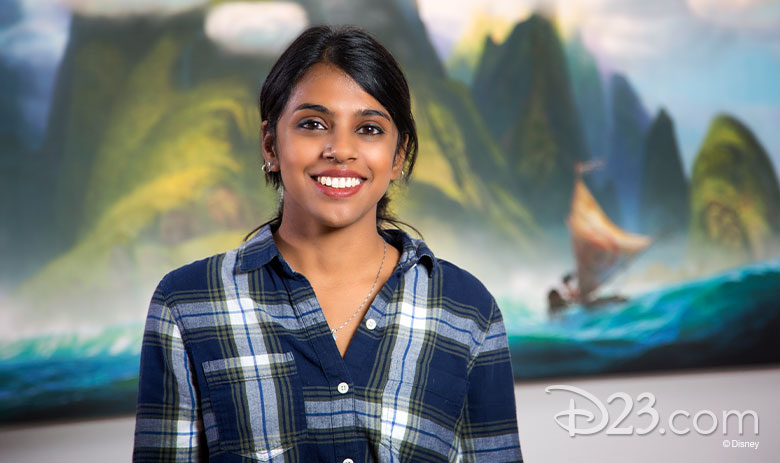
Can you describe your role in bringing Raya and the Last Dragon to the screen?
My job title on Raya and the Last Dragon was Associate Technical Supervisor, focusing on Environments. I partner with my counterpart on the character side (Gabby, in this case), the technical supervisor (Kelsey), and work with the creative department heads and Technology to make sure that we have what we need to deliver the artistic and technical goals for the movie.
What made you want to pursue a career in animation technology? Any specific films or experiences that inspired you when you were younger?
I was always interested in art, though in hindsight I wasn’t very good. I grew up in India, where there isn’t a lot of focus on creative fields, although that is changing slowly, and went into Computer Science, which is the best way to find a job. But I still wanted to find something that would be a good mix of both and then I heard about the Technical Director role—and the rest is history. The Lion King will continue to be among my favorite movies. And I remember watching Tangled and thinking, “How cool would it be to do that?”
What words of encouragement would you offer to women who are thinking of pursuing a similar path?
From a technical aspect, this job is all about problem solving. A programming background is essential since we build a lot of tools for the artists. I’d also add: Be curious and open-minded and don’t be afraid to ask questions because that’s a great way to learn. Having mentoring, tutoring, and TA [teaching assistant] experience also goes a long way, since a lot of our day is people-facing and having good soft skills is a huge plus.
Alena Wooten, Character Modeling Supervisor

Can you describe your role in bringing Raya and the Last Dragon to the screen?
As a Character Modeling Supervisor, I provide direction and feedback to my team, as well as work closely with other department supervisors. I help translate 2-D drawings into fully 3-D models—similar to clay sculpting—but on the computer. I help my team create the shape language and visual appeal of the characters that become the characters we see on the screen. We set the foundation of the characters for all the other departments to build on top of in the character asset team, which includes Rigging, Simulation, Look, Technical Animation, and Animation. It’s a very collaborative process.
What made you want to pursue your career? Are there any specific films or experiences that inspired you to want to work at Disney Animation?
I grew up watching Disney films; they were a huge part of my life. I was the only artistic one in my family. While my sister was watching TV, I’d sit and draw any and all Disney characters. Granted, my drawings weren’t that great but the characters excited me and I was drawn to how magical they were. I became a huge fan of Disney maquettes later on, and as I went to college studying Business Management, I found my passion in traditional sculpting. After college, I spent a year practicing and learning how to sculpt. In fact, one character I was inspired by was Kuzco from The Emperor’s New Groove. I found a 2-D turnaround sheet online and sculpted the maquette! I started working at Blue Sky Studios in 2012 as a sculpting assistant, switched to digital shortly after, and found my way to Disney as a character modeler. It was a complete circle!
What words of encouragement would you offer to young women who would also like to pursue a similar career in animation?
I think the one thing I would say to young women is, “You can do it! You always have!” Now is the time and place for you to be you and own your magic. Be true to yourself. Know you always have what it takes to do your passion and find your place; now you have the opportunity to shine. I feel this question should be, “What encouragement do I have to [all] young people?” as we are all one and all equal… It’s important to know we are united.
Avneet Kaur, Simulation Supervisor

Can you describe your role in bringing Raya and the Last Dragon to the screen?
I essayed the role of Simulation Supervisor on this film. My team was responsible for creating simulation setups for authoring cloth and hair performances for every character in the film. Character designs in this fantastical world of Kumandra were inspired by the many cultures of Southeast Asia. Realizing the unique wrapped clothing (like the sampot, dhoti, and wrap) was a new and interesting challenge in this film. My team and I collaborated very closely with other asset departments and character designers to bring our beautiful characters to life.
Raya and the Last Dragon is a fantasy action-adventure with themes of community and trust. Building upon this sense of community and supporting one another was the key in being able to accomplish the high level of artistry on the film. A sentence we used to describe the film is, “It takes more than a dragon to save the world; it takes trust and teamwork.” This became a living metaphor to describe how we all came together to accomplish the successful completion of the characters for this film, even when working from home.
On many fronts, this has personally been a very special film for me to work on. Having grown up in Asia, I am very proud of my heritage and I feel lucky to have gotten the chance to experience and synthesize the best of both worlds, which allowed me to bring a unique perspective to the table throughout the making of the film—from development through production. It’s truly been a dream come true to work on a Disney film that finds inspiration in the many cultures that are so close to my heart.
What made you want to pursue your career? Are there any specific films or experiences that inspired you to want to work at Disney Animation?
I always loved to draw as a kid. My family encouraged my passion for the arts and I studied architecture in India, which gave me a very well-rounded education—both in art and sciences. With a desire to advance my knowledge, I applied to the Masters of Visualization Sciences program at Texas A & M University, and it was while pursuing this program that I was exposed to the amazing world of creating animated features. I was completely intrigued by the amalgamation of the art and technology that went into making CG films. I had always loved films and had grown up watching all genres of Bollywood and Hollywood films, so I decided to pursue a job making animated movies, which allowed me to channel my passions and hobbies into a meaningful career. With an aspiration of working at Walt Disney Animation Studios, I joined the studio in 2005 and I feel blessed to be working here, every single day.
What words of encouragement would you offer to young women who would also like to pursue a similar career in animation?
If you have the willpower, grit, and resilience never to give up on your aspirations and dreams, you will surely find your way to fulfill them.




